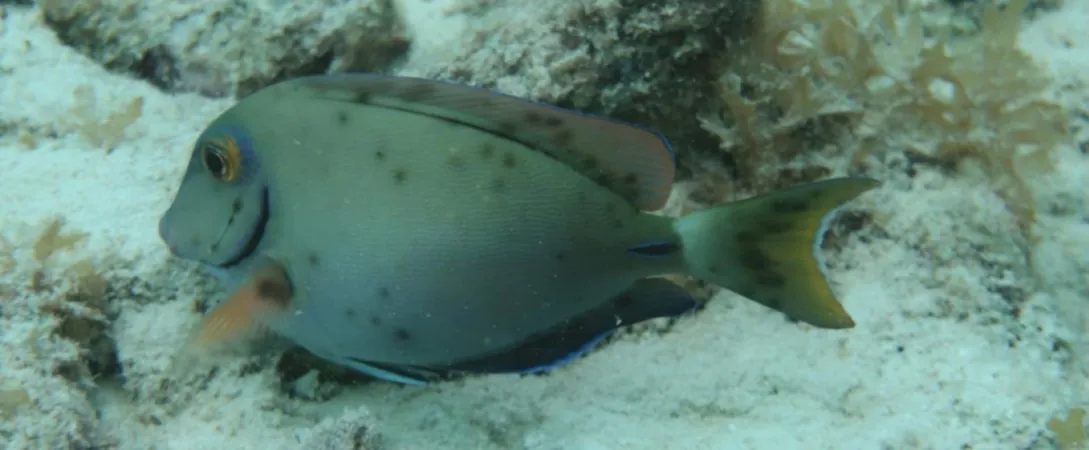
Fish on Film: The Alarming Rise of Black Spot Syndrome and Its Environmental Triggers
2024-11-18
Author: Mei
What is Black Spot Syndrome?
Black spot syndrome is characterized by the presence of black or white dermal lesions on affected fish, a result of parasitic trematodes—specifically the Scaphanocephalus genus—penetrating the fish's skin and forming harmful cysts. The lesions are a biological response to the invasion, as fish deploy melanin around the cysts, akin to how oysters form pearls. Little is known about this particular genus of trematode, which was only identified in Caribbean fish in 2017. Alarmingly, about 70% of surgeonfish observed in the recent study exhibited signs of this distressing disease. The presence of these parasites not only compromises fish health, potentially diminishing their grazing efficiency and making them more visible to predators such as ospreys but also poses a significant threat to the entire reef ecosystems they inhabit.
Environmental Factors at Play
The study, led by Professor Pieter Johnson from the University of Colorado Boulder, and Cheyenna de Wit from the University of Amsterdam, reveals that urban and industrial development is likely exacerbating the severity of black spot syndrome. The researchers found that the prevalence and intensity of the disease increased from the eastern to the western coasts of Curaçao, where areas with more development showed higher infection rates. Wave intensity also plays a role; higher wave energy can help disperse larval trematodes, reducing infection rates. Conversely, increased nutrient runoff from human activities heightens the populations of trematode hosts and compromises fish immune systems, creating a perfect storm for disease spread.
The Ripple Effect on Ecology
The implications of black spot syndrome reach far beyond individual fish health—herbivorous fish like surgeonfish and parrotfish are crucial to maintaining the delicate balance of coral reef systems. These fish help control algal growth, and when infections lead to reduced grazing, unchecked algae can suffocate corals, resulting in ecosystem collapse. The decline in grazing fish populations due not only to disease but also due to fishing pressures (as these species are highly sought after by fisheries) leaves coral reefs vulnerable to overgrowth, threatening the biodiversity that relies on these habitats.
Revolutionary Research Techniques
Johnson and de Wit's use of video transects allows for a more extensive and less invasive examination of fish populations. By collecting footage at various depths across 35 sites in Curaçao, the researchers recorded fish behavior and the extent of visible lesions instead of resorting to dissection. This innovative methodology can potentially revolutionize marine studies by utilizing community science platforms, where divers and vacationers can share their observations and images. As technology advances, the hope is that this collaborative approach will scale up efforts to monitor and mitigate the impact of diseases like black spot syndrome across various marine environments.
Conclusion
Overall, the study highlights the urgent need for enhanced environmental management practices to counteract the human-induced factors contributing to the spread of such diseases. If we are to protect the delicate balance of our oceans, concerted action is required to improve waste management, reduce nutrient pollution, and regulate fishing practices. The future of our coral reefs—and the fish that inhabit them—may depend on it.

 Brasil (PT)
Brasil (PT)
 Canada (EN)
Canada (EN)
 Chile (ES)
Chile (ES)
 España (ES)
España (ES)
 France (FR)
France (FR)
 Hong Kong (EN)
Hong Kong (EN)
 Italia (IT)
Italia (IT)
 日本 (JA)
日本 (JA)
 Magyarország (HU)
Magyarország (HU)
 Norge (NO)
Norge (NO)
 Polska (PL)
Polska (PL)
 Schweiz (DE)
Schweiz (DE)
 Singapore (EN)
Singapore (EN)
 Sverige (SV)
Sverige (SV)
 Suomi (FI)
Suomi (FI)
 Türkiye (TR)
Türkiye (TR)